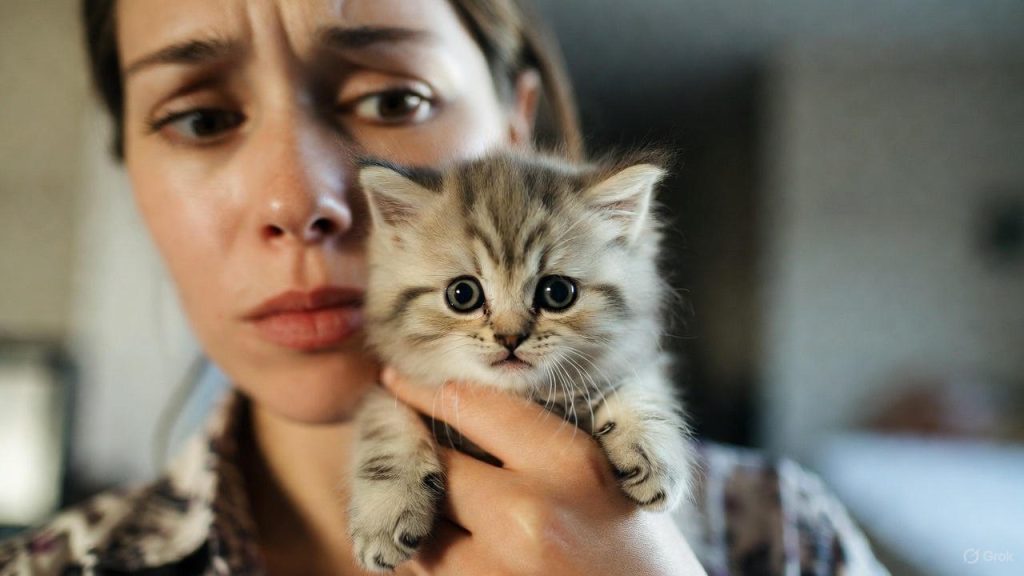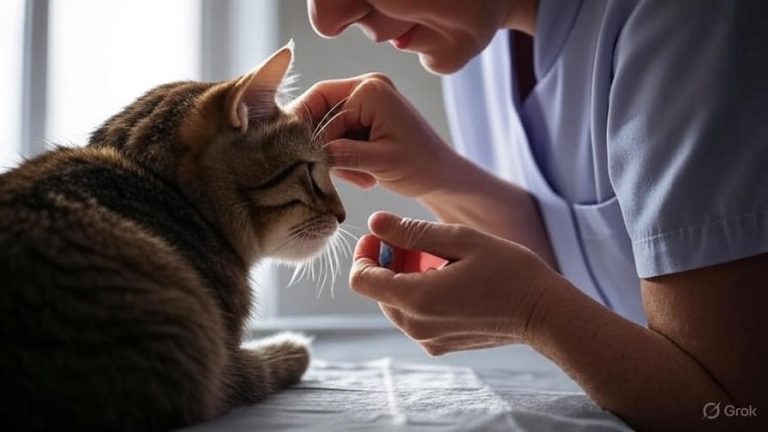How to Get My Kitten to Eat?
You’ve brought home the most adorable ball of fluff, but there’s just one problem – your kitten refuses to eat. The food bowl sits untouched, and you’re starting to panic. I get it. Watching your tiny feline friend skip meals can make any pet parent feel helpless.
The good news? Most feeding issues with kittens are totally fixable. I’ve spent years working with cats, and I’m going to share everything that actually works when you need to encourage a reluctant kitten to eat.
Why Your Kitten Won’t Eat
Before we jump into solutions, let’s talk about what’s really going on. Kittens stop eating for many reasons, and figuring out the cause makes all the difference.
Stress from a new environment tops the list. Your kitten just left their mother, siblings, and everything familiar. The new smells, sounds, and people in your home can be overwhelming. Some kittens hide and refuse food for the first day or two. This is normal.
Health problems can also cause appetite loss. Upper respiratory infections are super common in young cats. When kittens can’t smell their food, they won’t eat it. Dental issues, stomach upset, and parasites like worms can all make eating painful or unappealing.
Wrong food type might be the culprit. If you switched brands suddenly or offered something very different from what the kitten ate before, they might turn their nose up at it. Kittens can be picky little creatures.
Temperature matters more than you think. Kittens hate cold food. If you’re serving meals straight from the fridge, that could explain the problem.
Quick Solutions That Work Right Now
Let’s get your kitten eating today. These tricks have saved countless meals in my experience.
Warm Up the Food
Cold food has almost no smell. Heat your kitten’s wet food in the microwave for 5-7 seconds. Test it with your finger first – it should feel barely warm, never hot. The aroma will be much stronger, and most kittens find warm food irresistible.
Try Different Textures
Wet food comes in pate, chunks in gravy, shredded, and minced varieties. Some kittens love smooth pate while others prefer chunks they can pick at. Buy small cans or pouches of different textures and see what your kitten goes crazy for.
I’ve seen kittens who refused pate completely devour the same flavor in shredded form. It’s weird, but cats are weird.
Add Some Stink
The smellier, the better. Mix a tiny bit of tuna juice (from canned tuna in water) into the food. You can also try:
- A sprinkle of bonito flakes (dried fish flakes made for cats)
- A small amount of chicken baby food with no onion or garlic
- A teaspoon of kitten milk replacer mixed into wet food
- The juice from a can of plain chicken breast
These smell enhancers make food impossible to ignore. Just use them sparingly – you want to enhance the regular food, not create a picky eater who only wants tuna.
Make It Easy to Access
Kittens are small and sometimes food bowls are too deep. A shallow plate or saucer works better. Your kitten should be able to eat without shoving their whole face into the dish.
Place the food bowl in a quiet spot away from the litter box. Cats won’t eat where they potty. Also, keep the food away from their water bowl – cats naturally avoid drinking where they eat.
Hand Feed for Trust
Sit on the floor with your kitten. Put a small amount of food on your finger and let them lick it off. This creates positive associations and helps scared kittens feel safe. Once they start eating from your finger, guide them to the bowl.
Some kittens need this connection for the first few days. It’s time-consuming but incredibly effective for building trust.
Setting Up the Perfect Feeding Routine
Consistency helps kittens feel secure and eat better.
Feed on a Schedule
Kittens under six months need to eat 3-4 times per day. Set specific meal times and stick to them. Your kitten’s body will start expecting food at these times, which naturally increases appetite.
I recommend:
- 7-8 AM (breakfast)
- 12-1 PM (lunch)
- 5-6 PM (dinner)
- 9-10 PM (late snack for very young kittens)
Leave each meal down for 30 minutes. If your kitten doesn’t eat, pick it up and try again at the next scheduled time. Free-feeding (leaving food out all day) can actually make picky eating worse.
Create a Feeding Station
Your kitten needs a designated eating area that feels safe. Pick a quiet corner away from household traffic. No loud TVs, washing machines, or places where dogs can bother them.
Use a placemat to define the space and catch spills. This helps your kitten know exactly where meals happen.
Offer the Right Amount
Overestimating portions wastes food and makes it harder to tell if your kitten is eating. Check the feeding guidelines on your kitten food package. Most kittens need about 3-4 ounces of wet food per day for every pound they weigh.
A 2-pound kitten needs roughly 6-8 ounces total, split across multiple meals. Weigh your kitten weekly to track growth and adjust portions.
The Best Foods for Picky Kittens
Not all kitten food is created equal. What you feed matters as much as how you feed.
Go for High-Quality Wet Food
Wet food is easier to eat than dry kibble, especially for young kittens with baby teeth. It’s also more aromatic and contains the moisture kittens need.
Look for brands where real meat is the first ingredient. Avoid foods with lots of by-products, fillers like corn and wheat, and artificial colors.
Some kittens go absolutely nuts for certain brands. The common favorites include:
- Chicken or turkey flavors (usually more popular than beef or fish)
- Pate consistency for easy eating
- Grain-free formulas for sensitive stomachs
Don’t Completely Skip Dry Food
Once your kitten is eating well, introduce some high-quality dry kitten kibble. You can mix a few pieces into wet food or offer it separately.
Dry food helps clean teeth and gives kittens something to crunch. Just make sure they drink plenty of water when eating kibble.
Try Raw or Freeze-Dried Options
Some picky kittens respond amazingly well to freeze-dried raw food. You rehydrate it with warm water, and the smell drives cats wild. These foods are expensive but can be a lifesaver for stubborn non-eaters.
Always buy freeze-dried products specifically made for kittens. Adult cat formulas don’t have the right nutrients for growing babies.
Rotate Flavors
Feeding the exact same food every single day can lead to burnout. Buy 3-4 different flavors of the same brand and rotate them. This keeps meals interesting without upsetting your kitten’s stomach.
When switching flavors or brands, do it gradually. Mix 25% new food with 75% old food for a few days, then go to 50/50, then 75/25, and finally 100% new food. This prevents diarrhea and vomiting.
When Stress Is Stopping Your Kitten from Eating
Moving to a new home is traumatic for kittens. Here’s how to reduce stress and encourage eating.
Give Them a Safe Space
Set up a small room (like a bathroom) as your kitten’s base camp for the first few days. Include food, water, litter box, toys, and a hiding spot like a cardboard box.
This confined space feels safer than a whole house. Once your kitten is eating regularly in their safe room, you can gradually introduce them to the rest of your home.
Use Calming Products
Feliway makes a plug-in diffuser that releases calming pheromones. These can significantly reduce stress in new kittens. Plug one in near your kitten’s feeding area.
You can also try:
- Soft music or white noise
- A ticking clock wrapped in a blanket (mimics mother’s heartbeat)
- A warm (not hot) heating pad under half of their bed
- Lots of gentle talking and slow-blink eye contact
Limit Interactions at First
I know you want to play with and cuddle your new kitten constantly. Resist this urge for the first day or two. Let your kitten approach you when they’re ready.
Forced interaction increases stress. A stressed kitten won’t eat. Give them space, and you’ll have a lifetime of cuddles once they settle in.
Keep Things Quiet
Loud noises terrify kittens. If you have kids, teach them to use indoor voices around the kitten. Keep the TV volume down and avoid vacuuming near your kitten’s feeding area during meal times.

Medical Reasons Your Kitten Won’t Eat
Sometimes the problem isn’t behavioral – it’s medical. Know when to call the vet.
Watch for These Warning Signs
- Not eating for more than 24 hours
- Vomiting or diarrhea along with not eating
- Lethargy or sleeping much more than normal
- Discharge from eyes or nose
- Difficulty breathing or sneezing
- Weight loss or failure to gain weight
- A bloated or painful-looking belly
Any of these symptoms mean a vet visit today, not tomorrow.
Upper Respiratory Infections
Kittens get colds just like human babies do. Sneezing, runny nose, and watery eyes are common. When their nose is stuffed up, kittens can’t smell food and won’t eat it.
Your vet can prescribe medications to help. In the meantime, use a humidifier near your kitten and gently wipe their nose with a warm, damp cloth several times per day.
Intestinal Parasites
Worms are super common in kittens, even those from good breeders. Roundworms, hookworms, and other parasites can cause nausea, diarrhea, and appetite loss.
Your vet will do a fecal test and prescribe deworming medication if needed. Most kittens need deworming at 6, 8, and 12 weeks of age.
Dental Pain
Check your kitten’s mouth gently. Baby teeth falling out and adult teeth coming in can make eating uncomfortable. You might see red, swollen gums or broken teeth.
Soft, warm wet food is easier on sore mouths than dry kibble. If you notice severe redness, bad breath, or your kitten pawing at their mouth, see a vet.
Special Situations and Solutions
Every kitten is unique. Here are fixes for specific scenarios.
The Orphaned or Bottle-Fed Kitten
Kittens who lost their mothers very young sometimes struggle to transition to solid food. Start the weaning process around 4 weeks old.
Mix kitten milk replacer with high-quality wet food to make a soupy mixture. Gradually thicken it over 2-3 weeks. Some bottle babies need to lick food off your finger before they understand what solid food is.
Be patient. This process can take time, but every kitten eventually figures it out.
The Rescued Stray
Street kittens might be scared of people and refuse to eat in your presence. Set the food down and leave the room. Watch from a doorway if you need to.
As trust builds, you can stay in the room during meals. Eventually, your former stray will become a confident eater.
The Kitten Who Only Wants Dry Food
Some kittens refuse wet food completely if they only had kibble before. Don’t give up. Wet food is really important for hydration and overall health.
Crush dry kibble into a powder and sprinkle it over wet food. The familiar taste will encourage them to try the new texture. Reduce the kibble amount gradually until they’re eating plain wet food.
Multiple Kittens Who Fight Over Food
If you adopted siblings, they might be competing and this stress reduces appetite. Give each kitten their own bowl in separate spots. Stay in the room to supervise and make sure everyone eats.
Really aggressive food competition might mean you need to feed kittens in completely separate rooms.
Foods You Should Never Feed Your Kitten
Some human foods and ingredients are dangerous for cats.
Never give your kitten:
- Onions or garlic in any form
- Chocolate or anything with caffeine
- Grapes or raisins
- Milk from cows (most cats are lactose intolerant)
- Raw dough or bread with yeast
- Alcohol
- Xylitol (artificial sweetener)
- Bones that can splinter
- Raw eggs
- Fatty trimmings or cooked bones
These can cause serious illness or death. Stick to food specifically made for kittens.
Tracking Your Kitten’s Progress
Keep a simple log of what and when your kitten eats. This helps you spot patterns and gives your vet crucial information if you need help.
Write down:
- Time of each meal
- Amount offered
- Amount eaten
- Type and flavor of food
- Any vomiting or diarrhea
- Weekly weight
If your kitten is eating at least 2-3 meals per day and gaining weight steadily, you’re doing great. Kittens should gain roughly 1 pound per month in their early months.
A healthy kitten has a rounded belly after eating, bright eyes, a soft coat, and lots of energy for play. Their ribs shouldn’t be visible, but you should be able to feel them easily under a thin layer of fat.
Building a Positive Relationship with Food
Your goal isn’t just to get your kitten eating – it’s to create a healthy, happy eater for life.
Make meal time calm and positive. Don’t chase your kitten with food or force them to eat. This creates negative associations. Instead, offer food calmly, praise any interest, and remove uneaten food without drama.
Never punish a kitten for not eating. This only increases stress and makes the problem worse. Stay patient and consistent.
Play with your kitten before meals. Active play burns energy and builds appetite. A 10-minute play session with a feather wand or toy mouse gets their hunting instincts going. After the “hunt,” cats naturally want to eat.
Your Action Plan Starting Today
Here’s exactly what to do right now to get your kitten eating:
Today: Warm up a high-quality wet food, offer it in a shallow dish in a quiet spot, and sit nearby while your kitten explores it. Try hand-feeding if they seem scared.
This Week: Establish a feeding schedule with 3-4 meals at the same times daily. Try different flavors and textures to find favorites. Set up a dedicated, calm feeding area.
This Month: Track your kitten’s weight weekly and adjust food amounts as they grow. Rotate between 3-4 preferred flavors. Schedule a vet check-up to rule out medical issues.
Long Term: Maintain consistent meal times, continue weighing monthly, and keep building positive associations with food through play and calm feeding environments.
You’ve Got This
Dealing with a kitten who won’t eat is stressful, but you’re not alone. Most kittens go through this phase, and with patience and the right techniques, your little furball will soon be devouring every meal.
Start with the basics: warm food, strong smells, and a quiet feeding spot. If those don’t work within 24 hours, try the stress-reduction tips and consider a vet visit. The vast majority of feeding problems resolve within a week once you find the right approach.
Your kitten is lucky to have such a caring owner. Keep trying different strategies, stay calm, and remember that this is temporary. Soon enough, you’ll probably be dealing with a cat who screams for food at 5 AM instead of one who won’t eat at all.
Trust your instincts. If something feels wrong, call your vet. But in most cases, a few simple changes will have your kitten cleaning their bowl in no time.
Now go warm up some delicious kitten food and give these tips a try. Your baby cat is counting on you, and I have complete confidence you’ll figure this out together.







